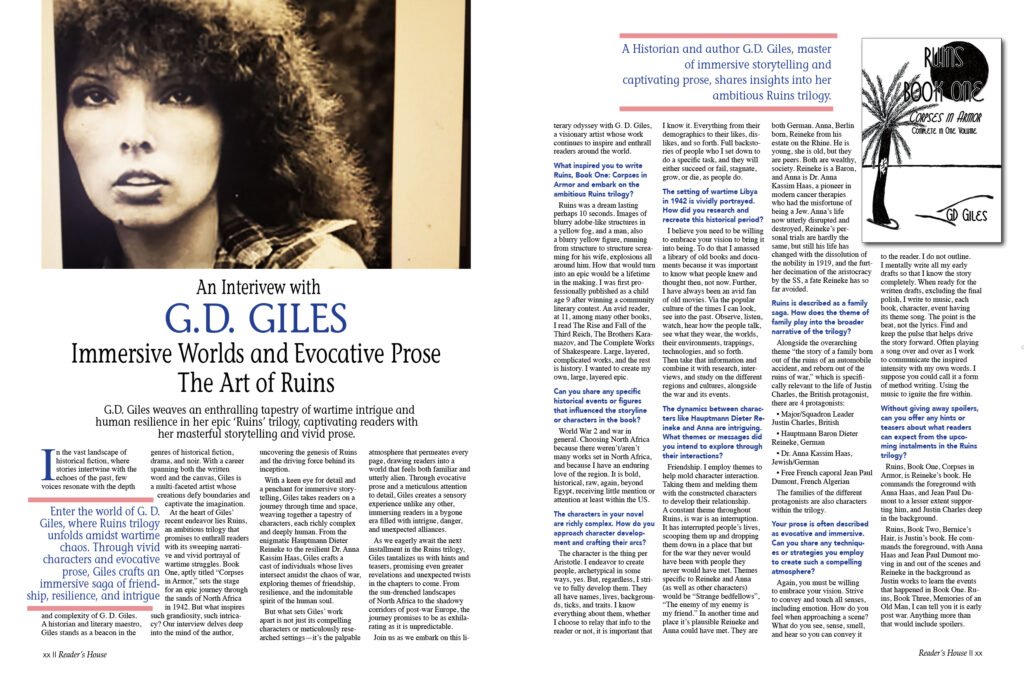Immersive Worlds and Evocative Prose: The Art of Ruins
Enter the world of G. D. Giles, where Ruins trilogy unfolds amidst wartime chaos. Through vivid characters and evocative prose, Giles crafts an immersive saga of friendship, resilience, and intrigue.
In the vast landscape of historical fiction, where stories intertwine with the echoes of the past, few voices resonate with the depth and complexity of G. D. Giles. A historian and literary maestro, Giles stands as a beacon in the genres of historical fiction, drama, and noir. With a career spanning both the written word and the canvas, Giles is a multi-faceted artist whose creations defy boundaries and captivate the imagination.
At the heart of Giles’ recent endeavor lies Ruins, an ambitious trilogy that promises to enthrall readers with its sweeping narrative and vivid portrayal of wartime struggles. Book One, aptly titled “Corpses in Armor,” sets the stage for an epic journey through the sands of North Africa in 1942. But what inspires such grandiosity, such intricacy? Our interview delves deep into the mind of the author, uncovering the genesis of Ruins and the driving force behind its inception.
With a keen eye for detail and a penchant for immersive storytelling, Giles takes readers on a journey through time and space, weaving together a tapestry of characters, each richly complex and deeply human. From the enigmatic Hauptmann Dieter Reineke to the resilient Dr. Anna Kassim Haas, Giles crafts a cast of individuals whose lives intersect amidst the chaos of war, exploring themes of friendship, resilience, and the indomitable spirit of the human soul.
But what sets Giles’ work apart is not just its compelling characters or meticulously researched settings—it’s the palpable atmosphere that permeates every page, drawing readers into a world that feels both familiar and utterly alien. Through evocative prose and a meticulous attention to detail, Giles creates a sensory experience unlike any other, immersing readers in a bygone era filled with intrigue, danger, and unexpected alliances.
As we eagerly await the next installment in the Ruins trilogy, Giles tantalizes us with hints and teasers, promising even greater revelations and unexpected twists in the chapters to come. From the sun-drenched landscapes of North Africa to the shadowy corridors of post-war Europe, the journey promises to be as exhilarating as it is unpredictable.
Join us as we embark on this literary odyssey with G. D. Giles, a visionary artist whose work continues to inspire and enthrall readers around the world.
What inspired you to write Ruins, Book One: Corpses in Armor and embark on the ambitious Ruins trilogy?
Ruins was a dream lasting perhaps 10 seconds. Images of blurry adobe-like structures in a yellow fog, and a man, also a blurry yellow figure, running from structure to structure screaming for his wife, explosions all around him. How that would turn into an epic would be a lifetime in the making. I was first professionally published as a child age 9 after winning a community literary contest. An avid reader, at 11, among many other books, I read The Rise and Fall of the Third Reich, The Brothers Karamazov, and The Complete Works of Shakespeare. Large, layered, complicated works, and the rest is history. I wanted to create my own, large, layered epic.
Can you share any specific historical events or figures that influenced the storyline or characters in the book?
World War 2 and war in general. Choosing North Africa because there weren’t/aren’t many works set in North Africa, and because I have an enduring love of the region. It is bold, historical, raw, again, beyond Egypt, receiving little mention or attention at least within the US.
The characters in your novel are richly complex. How do you approach character development and crafting their arcs?
The character is the thing per Aristotle. I endeavor to create people, archetypical in some ways, yes. But, regardless, I strive to fully develop them. They all have names, lives, backgrounds, ticks, and traits. I know everything about them, whether I choose to relay that info to the reader or not, it is important that I know it. Everything from their demographics to their likes, dislikes, and so forth. Full backstories of people who I set down to do a specific task, and they will either succeed or fail, stagnate, grow, or die, as people do.
The setting of wartime Libya in 1942 is vividly portrayed. How did you research and recreate this historical period?
I believe you need to be willing to embrace your vision to bring it into being. To do that I amassed a library of old books and documents because it was important to know what people knew and thought then, not now. Further, I have always been an avid fan of old movies. Via the popular culture of the times I can look, see into the past. Observe, listen, watch, hear how the people talk, see what they wear, the worlds, their environments, trappings, technologies, and so forth. Then take that information and combine it with research, interviews, and study on the different regions and cultures, alongside the war and its events.
The dynamics between characters like Hauptmann Dieter Reineke and Anna are intriguing. What themes or messages did you intend to explore through their interactions?
Friendship. I employ themes to help mold character interaction. Taking them and melding them with the constructed characters to develop their relationship. A constant theme throughout Ruins, is war is an interruption. It has interrupted people’s lives, scooping them up and dropping them down in a place that but for the war they never would have been with people they never would have met. Themes specific to Reineke and Anna (as well as other characters) would be “Strange bedfellows”, “The enemy of my enemy is my friend.” In another time and place it’s plausible Reineke and Anna could have met. They are both German. Anna, Berlin born, Reineke from his estate on the Rhine. He is young, she is old, but they are peers. Both are wealthy, society. Reineke is a Baron, and Anna is Dr. Anna Kassim Haas, a pioneer in modern cancer therapies who had the misfortune of being a Jew. Anna’s life now utterly disrupted and destroyed, Reineke’s personal trials are hardly the same, but still his life has changed with the dissolution of the nobility in 1919, and the further decimation of the aristocracy by the SS, a fate Reineke has so far avoided.
Ruins is described as a family saga. How does the theme of family play into the broader narrative of the trilogy?
Alongside the overarching theme “the story of a family born out of the ruins of an automobile accident, and reborn out of the ruins of war,” which is specifically relevant to the life of Justin Charles, the British protagonist, there are 4 protagonists:
Major/Squadron Leader Justin Charles, British
Hauptmann Baron Dieter Reineke, German
Dr. Anna Kassim Haas, Jewish/German
Free French caporal Jean Paul Dumont, French Algerian
The families of the different protagonists are also characters within the trilogy.
Your prose is often described as evocative and immersive. Can you share any techniques or strategies you employ to create such a compelling atmosphere?
Again, you must be willing to embrace your vision. Strive to convey and touch all senses, including emotion. How do you feel when approaching a scene? What do you see, sense, smell, and hear so you can convey it to the reader. I do not outline. I mentally write all my early drafts so that I know the story completely. When ready for the written drafts, excluding the final polish, I write to music, each book, character, event having its theme song. The point is the beat, not the lyrics. Find and keep the pulse that helps drive the story forward. Often playing a song over and over as I work to communicate the inspired intensity with my own words. I suppose you could call it a form of method writing. Using the music to ignite the fire within.
Without giving away spoilers, can you offer any hints or teasers about what readers can expect from the upcoming instalments in the Ruins trilogy?
Ruins, Book One, Corpses in Armor, is Reineke’s book. He commands the foreground with Anna Haas, and Jean Paul Dumont to a lesser extent supporting him, and Justin Charles deep in the background.
Ruins, Book Two, Bernice’s Hair, is Justin’s book. He commands the foreground, with Anna Haas and Jean Paul Dumont moving in and out of the scenes and Reineke in the background as Justin works to learn the events that happened in Book One. Ruins, Book Three, Memories of an Old Man, I can tell you it is early post war. Anything more than that would include spoilers.
EDITOR’S CHOICE
“Ruins, Book One: Corpses in Armor” by G.D. Giles is a riveting masterpiece, seamlessly blending history, drama, and suspense. Unputdownable brilliance.”
G.D. Giles’s Ruins, Book One: Corpses in Armor is a captivating plunge into the tumultuous landscape of Libya in 1942. Set against the backdrop of World War II, Giles weaves a gripping narrative of unlikely alliances and moral dilemmas that transcend the traditional hero-villain dichotomy.





